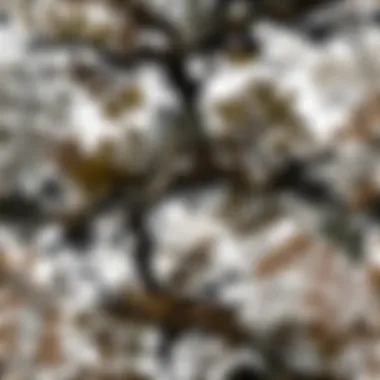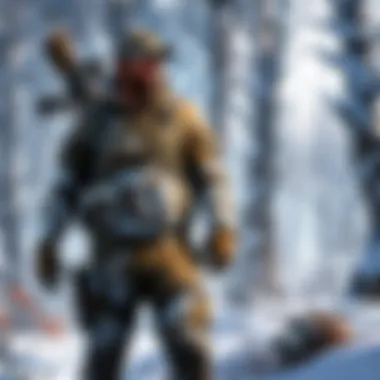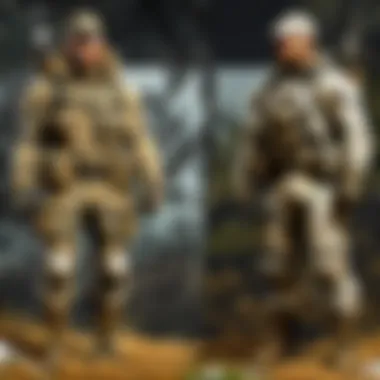The Importance of Camouflage in Modern Hunting Gear


Intro
Camouflage plays a crucial role in the realm of hunting, impacting both the effectiveness of hunters and the survival of wildlife. Historically, camouflaging garments have evolved significantly, transitioning from basic fabrics to sophisticated designs that enhance stealth in various environments. Understanding these advancements is not just about improving hunting success; it's also about aligning with ethical hunting practices and conservation efforts.
The Importance of Camouflage
Camouflage helps hunters blend in with their surroundings, minimizing visibility to prey. This is vital for maintaining the element of surprise and ensuring a successful hunt. Moreover, different environments call for specific camouflaging patterns. Hunters must assess the terrain and weather conditions to select the most effective camouflage.
Evolution of Hunting Camo
The development of camouflage patterns has been influenced by factors such as technology and ecological research. Initially, solid colors or simple patterns were common. However, the introduction of digital and 3D designs has revolutionized hunting gear. Today, patterns like Mossy Oak and Sitka are designed to mimic natural elements, enhancing the hunter's ability to remain undetected.
Psychological Effects
The impact of camouflage extends beyond mere concealment. It affects the psychological dynamic between hunter and prey. Prey species often rely on visual cues for survival, so effective camouflage can diminish their awareness. For hunters, effective camo contributes to a sense of security and confidence, facilitating a more proficient hunting experience.
Environmental Considerations
Effective camouflage must take into account various environmental factors, including lighting, vegetation, and seasonal changes. A pattern effective in autumn may not work in spring. As such, hunters need to adapt their gear to specific hunting scenarios, ensuring their camouflage remains effective throughout the year.
Ethical Hunting and Conservation
At the core of modern hunting is a commitment to conservation and ethical practices. Responsible hunters recognize the importance of their role in maintaining ecological balance. Utilizing effective camouflage is just one aspect, as hunters must also comply with regulations and support habitat preservation efforts. This alignment of practices contributes to a sustainable future for both hunting and wildlife.
Prologue to Hunters Camo
In the realm of modern hunting, the importance of hunters camo cannot be overstated. Camouflage serves as a vital tool for hunters, optimizing their ability to blend into the environment while maintaining a stealthy approach to their prey. Understanding the intricacies of camo can significantly influence the success of a hunt. This article will scrutinize various facets of camouflage, exploring both historical and technological advancements.
One primary benefit of using camouflage gear is the enhanced concealment it offers. By breaking up the silhouette of the hunter, camo effectively disguises their presence from prey. This is especially relevant when engaging with animals that possess acute vision. To maximize effectiveness, selection of appropriate patterns in relation to the environment is crucial.
Moreover, hunters camo is not merely about aesthetics; it is grounded in biological science. The patterns and colors used in camouflage can mimic the background, aiding in visual deception. Additionally, fabric technology plays a role in how well these designs function. Breathable, lightweight materials can improve mobility and comfort during extended periods in the field.
Another consideration in the discourse on camouflage is its psychological influence. The act of wearing effective camo can boost a hunter's confidence, fostering a more focused and productive approach to the hunt. Understanding these psychological elements allows hunters to appreciate how camo not only aids in concealment but also impacts their mentality as they pursue various game.
"Camouflage is not just about blending in; it is a strategic advantage that requires thoughtful selection and understanding of the environment."
Lastly, the ethical use of camouflage should be highlighted. As conservation awareness grows, responsible hunting practices and the application of camouflage must go hand in hand. This ensures that hunting remains sustainable, protecting wildlife and their habitats for future generations.
In the following sections, we will delve deeper into the historical context, types of camouflage patterns, and advancements in technology. Understanding the relevance of these elements will provide a comprehensive overview of the role of hunters camo in contemporary hunting.
Historical Context of Hunting Camo
The historical context of hunting camouflage plays a crucial role in understanding its evolution and significance in modern hunting practices. Traditionally, hunters relied upon natural elements in their surroundings to blend in, utilizing available materials such as leaves, branches, and mud. This method of camouflage was not only practical but reflected the hunter's deep connection to their environment. Over time, as hunting became more commercialized and competitive, the need for specialized camouflage patterns arose.
Traditional Patterns and Methods
Historically, camouflage was primarily about adaptation to the environment. Native civilizations developed their own unique methods based on local flora and fauna. For example, indigenous hunters in various regions adopted patterns that closely resembled their hunting grounds. The effectiveness of this approach relied heavily on the skills of the hunter to choose appropriate patterns that matched the landscape.
Many early camouflaging techniques were simple. Hunters would cover themselves with natural materials found in their surroundings. This practice not only concealed them from game but also became a rite of passage in many cultures. As the importance of hunting grew, so did the sophistication of these methods.
In the mid-20th century, with the development of synthetic materials, hunting attire began to evolve. Companies started to create dedicated camouflage patterns, like the famous Army camouflage, designed to conceal soldiers in various environments. Hunters began to adopt these designs for their needs, leading to the birth of commercial camouflage gear tailored specifically for hunting.
Evolution Through the Decades
The evolution of camouflage patterns reflects Changes in hunting technology, as well as trends in wildlife and environmental conservation. The 1970s saw a surge in interest regarding the effectiveness of different camouflage patterns, leading researchers to study how animals perceive color and patterns. This research influenced the design of more specialized camouflage that mimicked real-life elements, such as bark or leaf shapes.
Subsequent decades introduced digital and computer-generated camouflage, which offered a new dimension in design. Brands like Mossy Oak and Realtree began to dominate the market by creating patterns that disrupted the human outline more effectively than traditional patterns.
The introduction of advanced materials also played a significant role. Light-weight, water-resistant fabrics enhanced comfort and utility in various weather conditions. This evolution indicates a shift towards functionality without compromising camouflage effectiveness.


Furthermore, as public awareness of environmental ethics grew, the camouflage industry made strides in sustainable practices. Efforts to use recycled materials in hunting gear began in the late 1990s. This evolution illustrates the dual responsibility hunters hold: to respect their quarry and conserve the environment.
Types of Camouflage Patterns
In the realm of hunting, the selection of the appropriate camouflage patterns is critical. Various types of camouflage can significantly influence a hunter's effectiveness. Understanding these patterns not only enhances the visual concealment but also complements a hunter's strategy in different environments. Moreover, the right choice can increase stealth and reduce the chances of detection by prey. This section observes natural patterns, digital patterns, and seasonal variations in camouflaging techniques, bringing forth their unique features and benefits.
Natural Patterns
Natural patterns are often inspired by the environment where hunting takes place. This includes designs mimicking foliage, bark, and other elements present in nature. The main goal is to blend seamlessly into the surroundings, effectively breaking up the hunter's silhouette.
- Advantages of Natural Patterns:
- Considerations:
- Enhanced visual integration with the environment.
- Often employ earthy tones that are subdued, making them ideal for various terrains.
- Proven effectiveness tested over generations in traditional hunting.
- Effectiveness can vary with seasonal changes in foliage and terrain.
- May not perform well in non-typical environments, like urban settings.
Natural patterns hold a historical significance, symbolizing the essence of hunting traditions. They tend to resonate with those who appreciate a classic approach to hunting.
Digital Patterns
Digital patterns have emerged in modern hunting gear, equipped with advanced technology. These patterns employ pixelated designs that confuse and disrupt the outline of a hunter. The randomness of shapes and colors provides an advantage, especially in environments that may have more varied textures and colors.
- Benefits of Digital Patterns:
- Considerations:
- Superior adaptability to different camouflage requirements.
- Potentially more effective at great distances.
- Breaks the outline more effectively in varied terrains.
- May not resonate with traditionalists who prefer natural aesthetics.
- The effectiveness can sometimes depend on the specific digital pattern chosen.
These patterns have gained popularity for their effectiveness in a wide range of conditions and environments, appealing to a more tech-savvy hunting audience.
Seasonal Variations
Seasonal variations in camouflage refer to the changes in patterns that cater to various climate and environmental conditions. As seasons shift, so does the landscape, demanding that hunters adjust their camouflage accordingly.
- Significance of Seasonal Variations:
- Considerations:
- Ensures that hunters remain concealed throughout the year.
- Adaptation enables effective hunting across diverse environments.
- Encourages awareness of the surroundings and the wildlife behavior associated with different seasons.
- Requires more than one type of camo to suit all seasons.
- Selecting the right pattern can involve additional planning and expense.
Seasonal variations reflect a dynamic approach to hunting, emphasizing the necessity of adaptability. Every hunter must evaluate the shifting landscapes to remain effective in their practice.
Technological Advances in Camouflage
The importance of technological advances in camouflage cannot be overstated in the context of modern hunting. These innovations have significantly changed the way hunters approach their activities, offering more effective ways to blend into diverse environments. Among these advances, two areas stand out: 3D camouflage technology and material science innovations. Both areas enhance the effectiveness of camouflage patterns and improve the overall hunting experience.
3D Camouflage Technology
3D camouflage technology represents a shift from traditional two-dimensional patterns to a more complex three-dimensional modeling approach. This technology incorporates layering and texturing that mimics natural surroundings more accurately. The goal is to disrupt the outline of the hunter’s body, making it less recognizable to both the prey and fellow hunters.
These patterns often employ elements like foliage attachments, which create shadows and depth. As a result, hunters utilizing this technology can achieve a genuinely immersive effect in their hunting environment. Furthermore, studies indicate that the increased visual complexity leads to higher success rates in hunting.
Some popular products featuring this technology include:
- Mossy Oak 3D Leafy Suit: Designed to create intricate textures that resemble actual foliage.
- Under Armour's Scent Control Technology: Not only camouflages visually but also minimizes human scent, addressing dual aspects of hunting.
Material Science Innovations
Material science has played a pivotal role in enhancing camouflage effectiveness. The development of advanced, lightweight, and weather-resistant materials has transformed hunting apparel and gear. Innovations like moisture-wicking fabrics and noise-reducing textiles improve the hunter's comfort and minimize sound, increasing stealth.
Additionally, many modern materials feature technological enhancements that incorporate UV patterns invisible to the naked eye but detectable by certain animals. This understanding of animal vision informs how manufacturers design camouflage products.


Some notable advancements in material science include:
- GORE-TEX: Known for its waterproof and breathable qualities, crucial for all-weather hunting.
- Primaloft insulation: Provides warmth without bulk, making it easier to move undetected.
"Effective camouflage today is not just about blending in. It’s about understanding the behavior of both the hunter and the hunted, ensuring a more ethical and successful hunt."
This focus on technology allows modern hunters to approach their sport with a level of sophistication and understanding that was not possible in previous decades. By incorporating these technological advances, hunters can ensure their practices are effective while aligning with ethical standards.
Psychological Effects of Camouflage
Camouflage serves more than just a practical purpose in hunting. It profoundly influences the mindset of hunters and affects the hunting experience in a variety of ways. Understanding these psychological effects is essential to appreciate how hunters connect with their environment. Often, successful camouflage results in increased hunter confidence. A well-designed camo pattern can create a sense of security, making the hunter feel more integrated with nature. This perception of invisibility not only enhances their hunting performance, it can also transform their emotional state, reducing anxiety and improving focus.
The efficacy of camouflage is tied to both psychological and emotional dimensions, which are vital for the overall experience of the hunt.
Impact on Hunter Confidence
For many hunters, the choice of camouflage can be a driving factor in their confidence levels. The belief that they are effectively concealed from their quarry enables hunters to approach situations with greater assurance. However, confidence does not stem solely from the appearance of the camouflage itself. It's also about how well the hunter understands its capabilities within different environments.
When hunters trust their gear, they are more likely to take calculated risks, leading to potentially greater success. A few key aspects impacting this confidence include:
- Familiarity with specific patterns and their effectiveness in various terrains.
- Knowledge about how animals perceive their surroundings, allowing hunters to adapt their tactics accordingly.
- Social reinforcement from peers who validate the effectiveness of specific camo brands or designs.
Perception of Prey
The psychology of camouflage extends beyond the hunter's experience; it also heavily influences the behavior and perception of the prey. Different animals have unique visual capabilities, and understanding these can significantly impact hunting strategies. For instance, many ungulates have dichromatic vision, meaning they see contrasts primarily in shades of blue and yellow. This information can guide hunters in selecting the appropriate camouflage patterns.
In terms of the prey's perception:
- Distracted Prey: Effective camouflage can distract or confuse prey. This gives the hunter a tactical advantage in minimizing detection.
- Awareness Levels: Animals operate on instinct and awareness, making them highly sensitive to movement rather than color. Therefore, hunters must be still to remain concealed, leveraging their camouflage to blend into the surroundings.
Field Testing Camouflage Effectiveness
Field testing camouflage effectiveness is crucial for modern hunters who rely on stealth to increase their success rates in the field. Unlike the simple notion of wearing camo clothing, effective camouflage involves evaluating how well that clothing actually helps the hunter remain undetected in a variety of environments. Understanding the true effectiveness of camouflage requires direct testing in real-world scenarios rather than relying solely on theoretical models or manufacturer claims.
Real-world Scenarios
Conducting field tests in real-world scenarios means taking camouflage into different landscapes and hunting conditions. Several factors influence how camouflage performs, including varying light conditions, patterns of natural vegetation, and even the behavior of specific wildlife in those areas. There is immense value in performing trials during varying seasons, such as spring and autumn when foliage changes, to understand how clothing blends into different settings.
For instance, a hunter may wear a specific camo pattern in a dense forest during summer, but the same pattern may not be as effective in a field during winter. Therefore, testing should reflect diverse and changing environments. This enables hunters to choose their camo gear based on the most relevant patterns for their hunting locations.
Factors Influencing Effectiveness
Several key factors determine the effectiveness of camouflage:
- Color Scheme: Colors that match the environment significantly improve invisibility. Hunters should consider shades and tones that align with their specific hunting area.
- Pattern Complexity: More complex patterns often help in breaking up the outline of the hunter's silhouette. Patterns designed to disrupt recognition can be more effective.
- Movement: How a hunter moves through the environment affects effectiveness. Staying still generally increases the likelihood of remaining unnoticed.
- Distance: The effectiveness of camo can diminish at close range. Animals might notice a hunter more easily when they approach within a certain distance.
- Time of Day: Early morning or late evening light can change how colors and patterns are perceived. Hunters need to ascertain how their camouflage appears at different times.
"Testing your gear under actual hunting conditions is the best way to ensure your success in the field."
By recognizing the significance of real-world application, hunters can refine their choices, adapt their techniques, and improve their hunting strategies.
Selecting the Right Camouflage
Choosing the right camouflage is a critical aspect of modern hunting. The effectiveness of a hunting expedition can hinge on how well a hunter blends into their surroundings. Poor camouflage choices can lead to detection by prey and ultimately unsuccessful hunts. Therefore, understanding the different factors that influence camouflage selection is vital for optimizing hunting success.
Hunting environments can vary greatly in appearance, from dense forests to open fields. An effective camouflage pattern must account for these variables. Adapting to specific environmental conditions helps ensure that hunters remain concealed. Additionally, selecting the right camouflage enhances the psychological aspects of hunting. When hunters feel confident in their gear, their performance may improve.
Assessing Environmental Conditions
Environmental conditions encompass a range of factors including terrain, vegetation, and seasonal changes. Each of these elements plays a pivotal role in deciding which camouflage pattern to select. For instance, in a dense forest, earthy tones and leaf patterns may be more effective, whereas in a snowy landscape, whites and light grays should be prioritized.
Key elements to assess include:


- Terrain Type: Evaluate whether the area is wooded, rocky, or open. Each terrain offers distinct visual challenges.
- Vegetation Density: Thicker vegetation may require different patterns than sparse shrubbery.
- Seasonal Variation: Colors adapt with the seasons. Autumn colors differ greatly from winter whites.
By carefully analyzing these factors, hunters can choose clothing that effectively disguises their presence.
Matching Camouflage to Hunting Style
Every hunting style demands unique strategies and gear. Consequently, it is essential for hunters to align their camouflage choice with their methods. Different styles, such as still-hunting, stand hunting, or driving, require a focused approach regarding camouflage.
Here are some points to consider:
- Still-Hunting: This method demands stealth and patience. Hunters may need patterns that blend well with their surroundings, focusing on minimizing movement.
- Stand Hunting: Elevated positions may require camouflage that protects against 360-degree visibility. Patterns that disrupt shape can be helpful.
- Driving Game: This style focuses on moving through terrain to push game into shooters. Here, more versatile and adaptable patterns might be advantageous.
Ethics in Use of Camouflage
Camouflage serves a pivotal role in hunting, but its application invites a broader ethical discussion. The utilization of camouflage is not just about concealment from prey; it encompasses a responsibility towards conservation and sustainable hunting practices. A deep understanding of these ethical dimensions benefits both hunters and the environments in which they operate.
Conservation Principles
Conservation principles form the backbone of ethical hunting. They emphasize the need to maintain biodiversity and protect ecosystems from overexploitation. Hunters who adopt ethical practices acknowledge their impact on the environment. By selecting camouflage that blends harmoniously into specific habitats, they minimize disruption to wildlife and promote respect for nature.
A responsible approach to camouflage includes:
- Promoting habitat integrity: Camouflage designs that align with local ecosystems not only aid hunters but also help in maintaining the natural balance.
- Supporting wildlife conservation organizations: Many camouflage brands contribute to efforts protecting habitats and endangered species. Choices made in hunting gear can reflect a commitment to these causes.
- Educating fellow hunters: Sharing knowledge about the environment and ethical practices within hunting communities cultivates a culture of conservation.
Responsible Hunting Practices
Responsible hunting practices extend beyond the gear itself. They involve a mindset of respect towards the animal kingdom and the principles of fair chase. Utilizing effective camouflage is just one aspect of a broader ethical framework. Hunters must commit to understanding regulations, practicing skillful techniques, and recognizing boundaries of sustainable hunting.
Key aspects of responsible hunting include:
- Following regulations: Adhering to local laws about hunting seasons and quotas is crucial. It ensures animal populations are managed responsibly.
- Practicing fair chase: Camouflage should enhance the experience of hunting without granting an undue advantage over prey.
- Preparation for ethical harvesting: Understanding and efficiently using gear is important for ensuring a quick and humane harvest.
"The effective use of camouflage goes hand in hand with responsible and ethical hunting practices."
Cultural Significance of Camouflage
Camouflage is not merely a functional aspect of hunting; it has deep cultural roots and meanings tied to various communities worldwide. Its significance extends beyond practicality into realms of identity, tradition, and even art. For hunting cultures, camouflage often symbolizes a connection to the land and the animals that inhabit it. This relationship shapes values around respect, conservation, and hunting ethics.
The role of camouflage in hunting communities can be substantial. Many hunters view it as an integral part of their hunting identity. Wearing the right camo allows hunters to blend with their environment, enhancing both effectiveness and experience. It evokes a sense of belonging, particularly when shared among peers. The patterns and designs can reflect local flora, fauna, and even community histories, reinforcing ties to specific regions.
"Camouflage speaks to our innate understanding of nature’s aesthetics and strategies. It’s more than just about hiding; it connects us to our surroundings."
Symbolism in Hunting Communities
In various hunting tribes and groups, camouflage serves as a symbol of skill and wisdom. The ability to use natural elements for disguise is viewed as a rite of passage. Camouflage patterns often carry stories and traditions. Some designs originate from ancestral knowledge passed down through generations. These patterns can embody respect for the prey, acknowledging the animal's role in the ecosystem.
Moreover, camo serves as a unifying element in hunting communities. Many brands produce specific patterns that resonate with cultural identities. For example, Realtree and Mossy Oak focus on designs that not only provide practical benefits but also celebrate a shared heritage. When hunters wear these garments, they showcase a collective commitment to maintaining traditions while adapting to modern practices.
Global Perspectives on Camouflage
The cultural significance of camouflage is not restricted to one geographical area. Various cultures have distinct approaches toward camouflage strategies. In North America, hunters favor specific patterns aligned with the diverse terrains. Meanwhile, in Asia, camouflage tends to reflect more on urban hunting practices, blending industrial elements with natural hues. This variation reflects how different lifestyles influence hunting techniques and design choices.
It's interesting to note that the meaning of camouflage can overlap with military contexts. Many cultures view camouflage as a representation of concealment and strategy. The techniques developed for military use have crossed over into hunting, inspiring innovative designs. In some regions, blending into surroundings becomes a matter of strategy—not just for survival, but also for sustaining traditional ways of life.
End
The conclusion serves a critical role in summarizing the main themes discussed in the article and reinforcing the importance of hunters camo in modern hunting practices. This section synthesizes the information presented throughout, linking the evolution of camouflage patterns to current technological advancements and ethical considerations. It emphasizes that the importance of effective camouflage goes beyond merely helping hunters remain unseen. Rather, it plays a significant part in shaping the relationship between hunters and wildlife.
Future of Camouflage Technology in Hunting
As we look toward the future, several trends in camouflage technology are worth noting. Innovations in material science are enabling the development of lighter, more breathable fabrics that retain effectiveness in diverse environments. Moreover, integration of smart technologies into camouflage gear is expected to revolutionize hunting.
Some potential advancements may include:
- Adaptive patterns: Camouflage materials that change based on the environment or lighting.
- Enhanced scent control: Fabrics that mask human odors or release pheromones to mislead prey.
- Augmented reality applications: Devices that provide real-time environmental analysis or tracking data.
These developments will likely not only improve the effectiveness of camouflage but also influence the strategies employed by hunters. As technology progresses, so too must the ethical considerations regarding its use, prompting ongoing discussions about conservation and responsible hunting practices.



